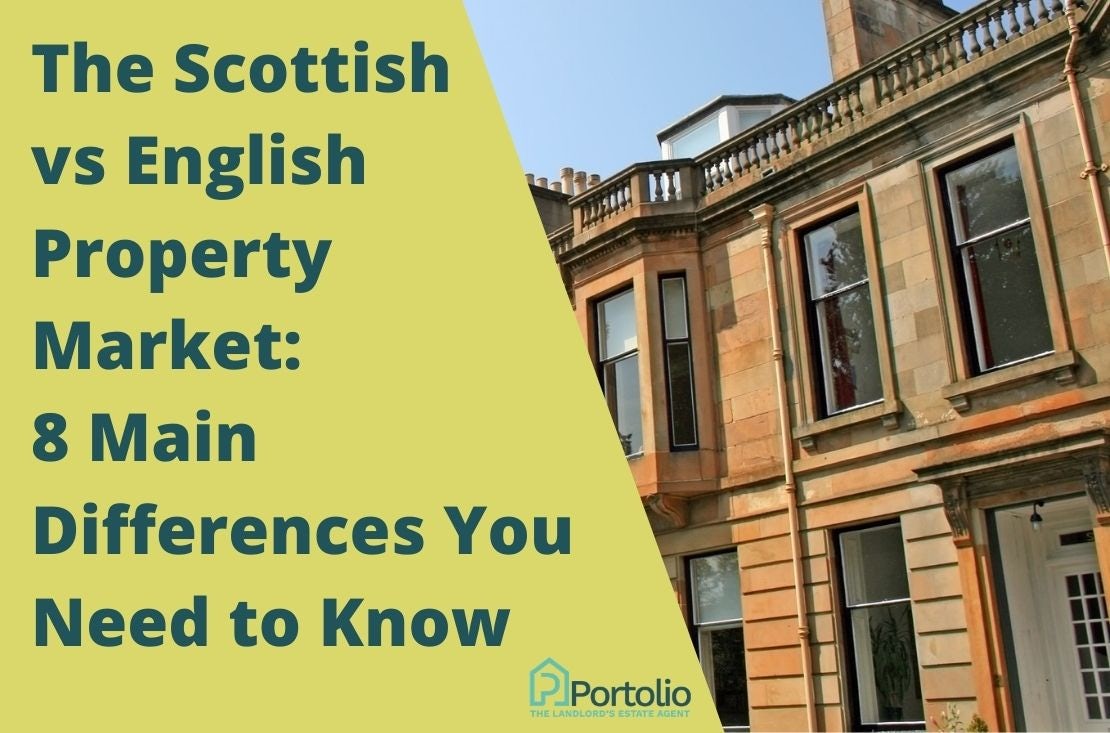Trying something new (like a new job or investment opportunity) can be exciting… but it can also mean venturing out of your comfort zone.
You might not imagine the Scottish property market is very different from England’s – after all, we’re only separated by a border, and tied together as part of one United Kingdom.
However, some of the differences between the Scottish vs English property market are very notable, and especially if it’s your first time looking into Scottish buy-to-let, it’s definitely worth reading up on.
93.3% of properties in the Scottish private rented sector are owned by landlords that live here, however we’ve seen a trend over the past six months of more and more investors coming from England, as well as further afield (Hong Kong, South Africa, and around the world).
It’s actually what prompted me to write this blog.
As a Scotland-based tenanted property specialist, I want to help highlight some of the subtle (and not-so-subtle!) differences of Scottish vs English property, and things to bear in mind when investing in Scottish buy-to-let.
Some of these might take you by surprise!
1. Freehold vs leasehold
When buying a property in England, it’s the custom (and just good sense!) to ask if a property is freehold or leasehold (the latter meaning you will only own the property, and not the land it’s built on, for a set number of years).
As a leaseholder in England (and also in Wales) you will effectively have rented the land, where the property sits, from what’s known as the ‘freeholder’ – also known as the landlord. You will pay a “ground rent” to the landlord.
DID YOU KNOW? Most flats and maisonettes in England and Wales are leasehold properties, however houses can occasionally be leaseholds, too. This is usually mostly the case in the North West.
This is completely unheard of in Scotland (at least nowadays, thanks to the Long Leases Scotland Act 2012), where even the previously very small number of leaseholds… now don’t exist.
Everything is freehold in Scotland, meaning you own the property, and the land the property sits on, outright. It becomes yours indefinitely – or until you decide to sell, or gift it to a relative.

2. Picking the suitable solicitor
When investing in Scottish property, the solicitor you use must be governed by the Law Society of Scotland, and be Scotland-based.
Equally, if buying a property in England would require a solicitor that is based in England and therefore governed by English laws. This is all due to the differences between Scots and English property law.
The right solicitor should be able to guide you through the process of buying property in Scotland, and help you prepare for the proper regulations here, such as proof of funds.
3. The ‘offers over’ system
In Scotland, we have a slightly different system when it comes to bidding, known as the ‘offers over’ system. In this system the estate agent invites interest in the property before setting a closing date – at which point “buyers’ submit their blind bid.
The “offers over” price is usually a price that is slightly under the property valuation price. It can be a price that is maybe £5,000 to £10,000 below the valuation but of course it can differ depending on the value.
This is almost unheard of in England, where anyone selling a property is more likely to put a fixed price on a property, so buyers can go straight in with an offer and it’s up to the seller to accept or decline.
I should maybe also say that the fixed price system exists in Scotland too, but is much less common. Just another difference between the Scottish vs English property market!
4. ‘Gazumping’
In England, it seems to be a regular occurrence that, despite an offer being initially accepted, it can then still be rejected at a later date if a better offer comes in.l
Commonly referred to as ‘gazumping’, this is a term that’s quite common in England, but again not so in Scotland. So, what is it exactly?
Let’s say you’ve done your research and due diligence on a property, either had a physical or virtual viewing (or both) and have put in an offer. It’s been accepted – happy days! Or… maybe not.
The seller can still reject your offer at a later date, in favour of a better offer at the very last minute from a third party. Ouch; you’ve just been gazumped! This happens due to the fact that, in English law, your agreement with the seller is not legally binding until the contracts have been signed.
At the end of the day, it’s the seller’s right to change their mind; even if it does seem unfair, and leads to a lot of stress, frustration, and wasted time and money for you.
NOTE: To clarify, a seller or buyer can still pull out of a deal in Scotland – for any reason – until the missives are signed, but ‘gazumping’ is far less common here.

5. Home reports
Another huge difference between the Scottish vs English property market is the presence of home reports. All properties to go on the market in Scotland must first get a home report, which is clearly displayed to anyone who has an interest in the property.
Upon making an offer, it may be necessary to arrange a survey if your lender requires one – and this is usually the only time the buyer will request an additional survey on the property.
In England, home reports don’t exist (although less comprehensive Home Information Packs are prepared), and the onus is on the buyer to carry out a survey after making an offer on the property in question. That offer will be subject to the results of the survey, which often leads to a lot of uncertainty.
If there are structural issues found or serious roof repairs required, the sale could fall through, potentially wasting both time and money and leading to a lot of frustration – in Scotland, home reports are a good way of avoiding such an outcome, and boosting buyer confidence.
6. Tax
When it comes to tax, it really benefits you to have an accountant who’s well versed on the differences and ensure everything goes smoothly.
The main difference is that in England, there’s stamp duty – whilst in Scotland, it’s LBTT (Land and Buildings Transaction Tax) you’ll have to pay when purchasing a property. However, it doesn’t end there.
TIP: You can calculate your tax rate in England via this link – whereas in Scotland, you can find out the tax you’re likely to pay using this calculator.
In Scotland, there’s also Additional Dwelling Supplement (ADS) at 4%, whereas in England, there’s SDLT (Additional Homes) at 3%. Although in Scotland, it’s worth bearing in mind there is relief on ADS when purchasing a property portfolio of six or more dwellings.
There’s also a 2% Overseas surcharge in England, payable if you’re not a UK resident (and have not been present in the UK for at least 183 days – six months – during the 12 months before your purchase).
7. Affordability
As I mentioned, many investors are starting to look further afield than areas such as London – with its high values and low yields no longer a safe bet – Manchester and Leeds (although I acknowledge there are affordable properties in other areas of England, too).
They’re beginning to see Scotland as a more attractive prospect, due to its affordable properties, good capital growth, high rental demand, and huge potential for returns – and there are often some great opportunities waiting to be snapped up.
For instance, despite Glasgow’s huge economy, you can actually buy two average houses for the same price as almost four in London. The average house price in Glasgow right now is around £123,577 – which happens to be 15% higher than the beginning of the past decade.
Of course, Scotland has a wide range of properties for sale, from more expensive postcodes in towns like the sought after St Andrews, and a host of ever popular hotspots in Edinburgh.
Overall, I would say that property values vs salary in these areas mean affordability is high, especially compared to some areas in England, such as the south of England, and even Manchester.

8. Rental demand
There isn’t such a difference between the Scottish and English rental market, but because affordability and demand often run hand in hand, it’s really worth taking a closer look at Scotland’s strong demand for its PRS.
As of last year, there were 325,649 properties in the Scottish private rented sector, meaning it’s now around three times the size it was in 1999.The average rent in Scotland increases by 4% year-on-year, with the average time to let standing at 28 days.
Advice from the property pros
Many property investors who extended their reach further north towards property hotspots, such as Manchester and Leeds, are now looking to extend even further towards Scotland.
Whether you’re in England, Wales, Ireland – or even further afield such as Hong Kong or China – buying UK property is attractive because of its extremely well-established success line, affordability, available lending, and good returns – all of which 100% applicable when it comes to Scotland.
If it’s your intention to invest in Scottish buy-to-let, perhaps for the first time, one of easiest ways to do so is buying pre-tenanted property. It’s a more hands-off approach than buying an empty property, which may require refurbishment and safety certificates before tenants are found.
Tenanted property comes fully-compliant, often fully-furnished, and with rent paying tenants living there. You don’t have zero void periods to worry about and you start receiving rental income from Day 1.
So, especially if you’re living further afield, buying tenanted property means you won’t have to worry about all the usual rigmarole when acquiring a new buy-to-let property.
It also removes some of the risk, and saves significantly on all of the costs associated with the above (we’ve actually written a blog highlighting how this method of buying could help you save around £30k on costs!).
In summary
Hopefully this blog has managed to shed a little more light on the Scottish vs English property market, and some of the main differences you need to bear in mind when investing here in Scotland.
Not everyone is aware of just how different the two markets can be when it comes to investing in property, and some of the above points may have come as a surprise.
Buying tenanted property here in Scotland is surprisingly simple, and with great benefits such as instant rental income, little to no outlay, and zero void periods to worry about, it’s an attractive option to many.
If you have any questions about buying tenanted property, please don’t hesitate to get in touch – or leave a comment below.
I’d love to hear from you, and will reply when I have time!
Written by Ross MacDonald, Director of Sales & Co-founder of Portolio
Get in touch on 07388 361 564 or email to [email protected]


- The Top 7 Buy-to-Let Property Investment Pitfalls – and How to Avoid Them
- Scottish Property Investment in 2021: Predictions from 13 of the Top Property Experts
- The Final Stage of Section 24 and What it Means for Landlords
- Should You Buy to Let as a Limited Company? [Pros and Cons]
- Should You Invest In Property During COVID-19?

Comments